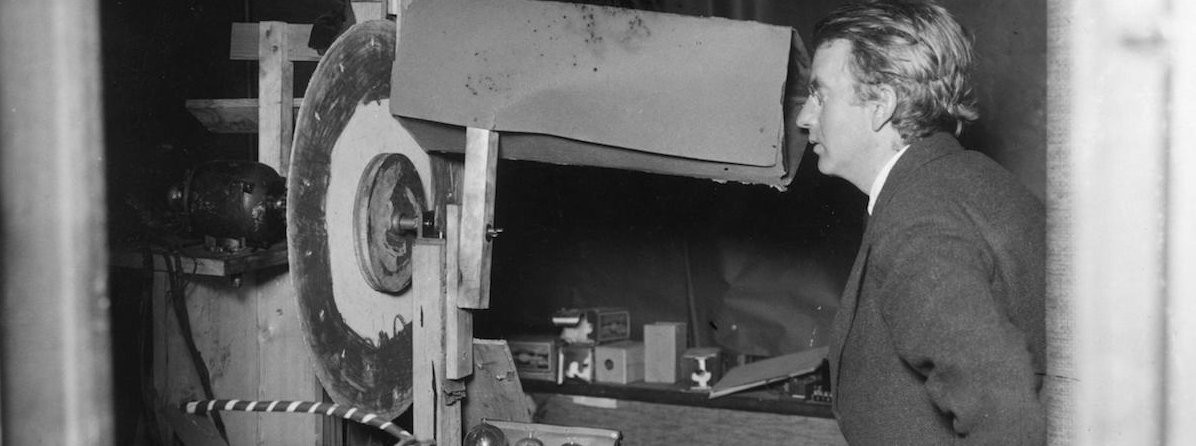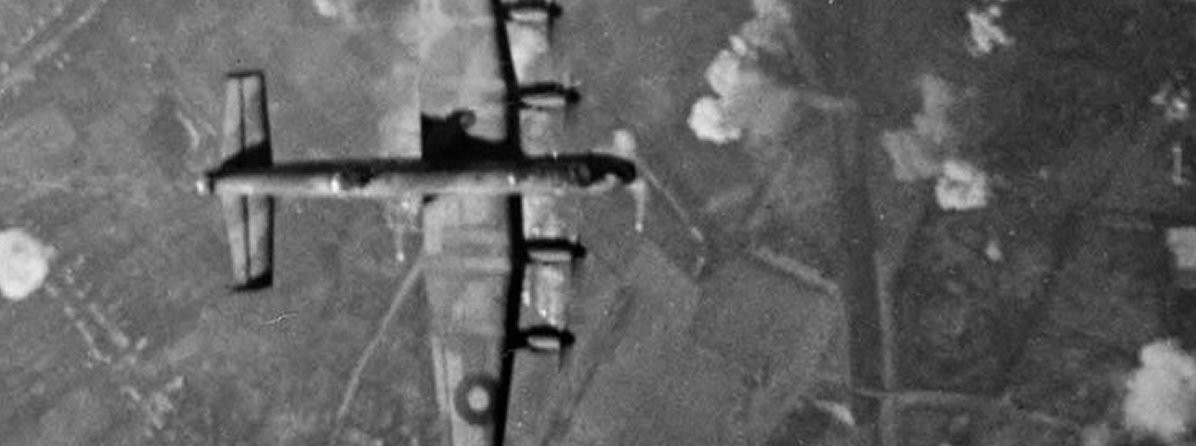
John Logie Baird - Television, Secret Experiments, Sabotage, Lies - Chapter 2
John Logie Baird - Chapter 2 - Progress and Secret Experiments
The early history of the subject of television dates back to 1817. The Swedish scientist Berzelius discovered selenium, a metalloid in the oxygen group with electrical properties. Then in 1873 a telegraph operator named Joseph May, working at the Velentia Cable Station in the West of Ireland, accidentally discovered that some selenium rods, which were used as resistances, altered in value under the influence of strong sunlight. The photosensitive properties of selenium led to the possibility of converting light waves into electrical impulses. This discovery was communicated to the Society of Telegraph Engineers and created widespread interest. Very soon selenium cells were constructed by Bell, Siemens and others, and these appeared to open up immense possibilities.
There were many attempts and suggestions for transmitting moving pictures through the ether before the end of the century and many predicted that in a short time it would be possible to obtain vision over an ordinary telephone line. Paul Nipkov's disc scanner made use of the selenium cell, but like other inventors and demonstrators around at that time his equipment lacked the means of amplifying the impulses. It appeared that the capabilities of selenium to respond to the stupendous speed of signalling involved were greatly overrated. Speed was the essential thing in television, for the whole idea was to transmit images with such rapidity that they appeared instantaneous to the eye, with movements as smooth and natural as that seen on a cinema screen.
Selenium had not been the only means of turning light into electricity available to the earlier television experimenters, for in 1888 Hertz and Hallwach made discoveries which led to the construction of photo-electric cells. These new cells seemed at first to offer an alternative to the sluggish selenium as they were capable of being instantaneous in their action. However, the photoelectric cells proved insufficiently sensitive and would not respond to the small amount of light available. It was discovered that a human face, brilliantly illuminated by a powerful bank of lamps, reflected back less light than that of one candlepower.
So, the problem of television, so simple in theory, had proved insurmountable in practice, and by the time John Logie Baird decided to begin experimenting with it once again, some progress had been made. The problem had been with a lack of an amplifier for the small current that a selenium cell produced. But thanks to Lee de Forest and Ambrose Fleming that problem was overcome, and such an amplifier was now in existence. No wonder it stretches credibility to believe that it was at No. 8 Queen's Arcade, Hastings, that John Logie Baird, an amateur inventor who had left his scientific career behind some years before, commenced his first serious attempt to solve the problem of television. He occupied a small attic room over a lock-up artificial flower shop, had scant funds at his disposal, nothing in the way of professional laboratory equipment, and was dogged by ill-health.
By this time it appears that Baird was confident with the theory of creating an apparatus suitable to transmit pictures, and in order to attract some interest from the press (and hopefully some investment), on June 27th 1923, he took out a small advertisement in The Times Personal Column, which read: SEEING by WIRELESS. -Inventor of apparatus wishes to hear from someone who will assist (not financially) in making working model. -Write Box S.686; The Times, E.C.4 He arranged for a demonstration for the press and a paragraph in The Daily News duly noted that "Mr John Logie Baird, of Hastings, yesterday demonstrated a device called the Televisor which, he claims, solves the problem of seeing by wireless."
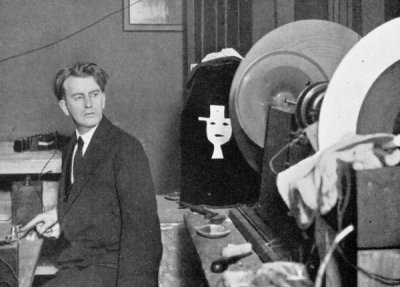
In his little room the first crude television apparatus of makeshift objects was assembled on the washstand that he used as his workbench. His equipment is described in Ronald F. Tiltman's book: "An old tea chest, purchased for a few pennies formed the base that carried a motor, which rotated the exploring disc, while an empty biscuit box housed the projection lamp. Scanning discs were cut out of cardboard, and the mountings consisted of darning needles and old scrap timber. The necessary lenses on the optical side of the apparatus were procured from bicycle shops at a cost of fourpence each, while electric motors ready for the scrap-heap were pressed into service on duties for which they were never intended. At the time there were a great deal of ex-Government wirelesses available for a very minimal cost, and Baird bought scraps of these for his own use, adapting them to his needs. One or two old hat boxes were also utilised, and the whole conglomeration of bits and pieces was precariously held together with glue, sealing wax and odd lengths of string. These early experiments also demanded a high use of electricity and this was supplied by accumulators, (storage batteries similar to those used in motor vehicles), for lighting." From this apparatus Baird experimented by trying to transmit a picture of a Maltese Cross that he had cut out of cardboard.
Baird considered that the theory of television was quite simple. Tiltman's book says: "All the requirements seemed to be two optical exploring devices rotating in synchronisation, a light-sensitive cell of some sort, and a controlled light source, capable of extremely rapid variation, and all of these appeared to be, to use a Patent Office term, "already known to the art." The problem of synchronisation appeared to have been practically solved in multiplex telegraphy: a number of optical exploring devices were known; the photo-electric cell in conjunction with the thermionic valve appeared to be a suitable light-sensitive device; and the glow discharge lamp seemed to be an ideal light source." At the same time, Baird realised that despite the theoretical simplicity of the task, it had continually confounded many experimenters over the years as they tried to bring their designs to practical accomplishment. He found that the main difficulty lay in the light sensitive cell and therefore concentrated all his efforts on that part of the system.
In this he enlisted help, in some part, from Victor Mills. In an article in the Hastings and St Leonards Observer dated 4th November 1978, Mills described Baird's recruiting method. Baird had read reports of a sophisticated wireless set built by a schoolboy at Hastings Grammar School. One day, in February 1923, Baird turned up on the doorstep of Mr Mills' family home. Called to the door by his mother, Victor Mills encountered Baird for the first time with the inventor telling him about his work on television. "What's television?" enquired young Victor. "Seeing by wireless," replied Baird. "You probably know something about resonance. I'm getting a picture but can't do anything with it. I'm getting too much noise."
Mills soon became a frequent caller to Baird's Queen's Avenue address. "He had a collection of junk," said Mills some years later. "I wouldn't give you two pounds to sell the lot." Mills claimed that he soon discovered the cause of Baird's problem was that his selenium cells were too big. Mills also claims that on his second trip to Baird's makeshift laboratory he took some of his own radio equipment with him. Whilst making adjustments, Mills put his hand in front of the illuminated apparatus. "I decided I'd got it right and just then Baird yelled out, "It's here, it's here!" And according to Mills the first pictures ever transmitted were of his hand.
This is yet another example of a contradictory account to what is held as popular fact, which tells us that following months of unremitting work on his crude apparatus, Baird's faith that he was pursuing the right line of investigation finally paid off when one afternoon, in early 1924 he got his various bits of equipment to hold together long enough to transmit the tiny pink flickering image of a Maltese cross over a distance of two to three yards, thereby achieving what no one had achieved before -the first image transmitted by television. But this would be at least twelve months after the Mills discovery. So, had Baird successfully transmitted a television picture before 1924? Had he in fact been successful long before that in Bath Street between 1918 and 1919, or in the West Indies shortly after that? And if he had made such a crucial, ground-breaking leap forward in television development before 1924, how could the news of such a monumental discovery be suppressed for anything up to six years? The answer may lie in the intervention of the military.
According to Jeffrey Cohen, documents found in the Public Records Office (PRO) at Kew, show that the military were quick off the mark in seeing the potential of television in warfare. In 1923, the Admiralty decided to start its own research and development work on television, and the file shows that the Air ministry had for 'some time' been following the 'possibilities of television' and felt 'the time had arrived when experimental work should be started.' On 28th November 1924, the Air Ministry in Kingsway, London, opened a secret file entitled 'Experiments in connection with the use of television in aircraft.'
By the time Baird made his first reported breakthrough in transmitting a picture, his meagre funds were completely exhausted. Realising the full necessity of getting financial assistance he demonstrated his crude results to the press once more. An account of his experiments appeared in the Kinematograph Weekly on 3rd April 1924. Reporter F.H. Robinson wrote that Baird had demonstrated to the writer's satisfaction that radio vision was almost "a commercial proposition." Robinson informed readers that all of the apparatus used in the experiment could be purchased for £40.00, and that, "...undoubtedly wonderful possibilities are opened up by this invention." The article attracted the interest of a certain Mr Will Day, a London cinema proprietor. Day was fascinated enough to purchase a one-third interest in the invention for £200.00 cash. This investment allowed Baird to continue his experiments, although for the time being he was unable to achieve any great improvement on the transmission of coarse shadows that he had obtained from his first success. When his money began to run out again Baird sold a further one-sixth interest to Will Day, now making them fifty-fifty business partners. It was then decided; in August of 1924, that Baird would pack up his makeshift gear and return with it to London. But Will Day wasn't the only interested party.
Military experts soon heard of Baird's claims and Baird was visited, according to Jeffrey Cohen, by a Mr William le Queux, who introduced himself as a journalist. 'However, le Queux, it appears, was frequently involved in undercover work for the government, and his purpose may have been to pass details of Baird's apparatus to the Admiralty's research team on TV at Teddington.' A note in the file discovered at the PRO contains the comment: 'I have been making abstracts of published accounts of Mr J. L. Baird's work with television since 1924. I have also discussed the matter with persons who have seen his apparatus and witnessed his demonstrations.' The note in the file is from an Intelligence Officer called Major Lefroy.
Moving to London, Baird took two attic rooms on the top floor of No 22 Frith Street, between Shaftsbury Avenue and Soho Square. In these rooms, Baird's crude apparatus was reassembled, and his experiments continued. Progress was made, but it was heartbreakingly slow. Gradually Baird advanced from the transmission of his "shadowgraphs" and succeeded in transmitting outlines of simple objects in black and white.
Here is another contradiction in the so-called accepted history of John Logie Baird. If Will Day was first alerted to Baird's work by the 1923 article in Kinematograph Weekly, then how do we account for the fact that Baird's first patent application, No 222,604, for a system of transmitting views, portraits and scenes by telegraphy or wireless telegraphy, and dated 26th July 1923, also names a Wilfred Ernest Day of Highgate, London? This predated the article by 15 months. Also of interest is that Baird's address on the patent application (which was eventually published on 9th October 1924) is given as The Lodge, Helensburgh (his family home in Scotland), and not his address in Hastings.
Baird had in actual fact returned to Helensburgh in 1923 on a visit that was recorded in the local paper under the heading "A Coming Wonder". The article reported that; 'Recently Mr Baird was in Helensburgh on a visit home and, in conjunction with Mr Youdall, of Messrs Youdall and Sprott, carried out several experiments in connection with his invention. Ill-health and a lack of material, however, drove him south and he has since been in Folkestone, Tunbridge Wells and London.' There is no mention of his residing in Hastings.
Folkestone seems an odd choice for a stopover, being less than fifty miles from Hastings where Baird had his equipment already set up as well as having the services of several people who were at this time assisting him in perfecting his apparatus. The only possible explanation for this would be that Baird was undertaking work in Folkestone that he wanted to keep from his colleagues in Hastings. If this is true, would it then be reasonable to assume that similar experiments were taking place in Tunbridge Wells? Norman Loxdale, who worked for Baird in Hastings, certainly thought so. He was convinced that Baird simply used the people around him to manufacture various items of machinery without actually explaining what they were for, and that these items were made at different locations to be assembled by Baird in private. He was under the impression that each of the people that were working for him was as much in the dark about Baird's ultimate aim as he (Loxdale) was.
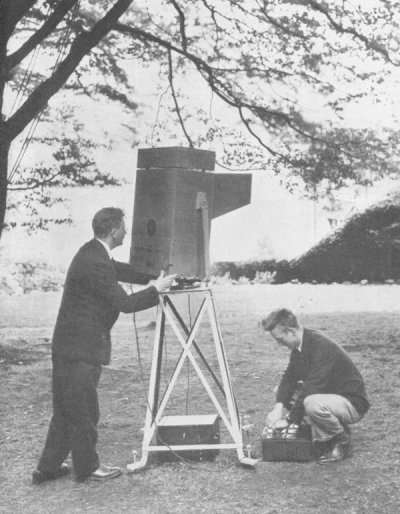
One particular Friday night in 1923, Loxdale and some friends were engaged by Baird to haul a particular piece of equipment up West Hill. "It was like a parabola, a reflector with a lot of associated equipment, also a converter." Loxdale later recalled. "It ran off a 12 or 16 volt car-type battery. I had only seen it twice. We were told to stop on the top of Lady's Path, one of the highest spots on West Hill. We set the equipment up. All of a sudden, he (Baird) remembered he had forgotten something. He told me to stay there. Meanwhile, my other three colleagues went back to the trek cart, leaving me alone up there. John eventually came back. He took the reflector, which had a form of spike in the middle with a knob on it, and first pointed it towards East Hill. At the same time he was looking into an opaque glass plate, not quite square, set into a case. Lines were being made on it. He then moved the reflector towards the sea and he said to me: "Come along and look at this." It wasn't fluorescing. All I saw was a brownish picture, not quite a picture. Something was moving on the screen."
After that night Loxdale said that he never saw that particular piece of equipment again. However, the equipment that Loxdale described is what Baird called a 'Noctovisor,' and in Moseley and Chapple's 1930 book, there is a detailed explanation of it. 'Noctovision,' (Baird's title) according to their chapter on it, is the 'science that bids to conquer darkness and fog.'
'In his first experiments with television, Mr. Baird found the greatest difficulty in reducing the intensity of the light used to illuminate his subjects without impairing the efficiency of the apparatus as a whole. The persons who sat before the scanning disc suffered considerable discomfort.' In order to eliminate this, Baird began experimenting with invisible rays instead of visible light. Ultraviolet rays were tried first but proved to be impracticable. Tiltman's 1933 book also recorded the technical detail of the 'Noctovisor': 'At this time it occurred to him that he was dealing not with the human eye in his apparatus but with a sensitive electric one which might detect rays outside the comparatively limited range of human eyesight. First he experimented with ultra-violet rays, but they proved unsatisfactory owing to the unpleasant effect on the skin and eyes of those being transmitted. They also had little penetration power, being quickly absorbed after passing through the air. Baird then turned his attention to the other end of the spectrum, outside the range of the human eye -infra-red.'
Infra-red rays had greater penetrating powers but also a very small photoelectric response, and in the early days it was almost impossible to obtain satisfactory results. And so, Baird decided to look at the optical side of the apparatus and experiment with increasing its efficiency in conjunction with the rays. In one experiment, Baird wanted to discover whether or not it was possible to use the rays so that images could be seen in total darkness.
This system required an absorption filter made from a thin sheet of ebonite. Moseley and Chapple wrote that 'Baird shielded all his "flood lights" with ebonite.' This produced a result that 'an infra-red image was focused by lenses onto the scanning disc with it's spiral holes. The photo electric cells were thus influenced by each elemental area of focused image that passed through the perforations, and the resultant variations of current were amplified, transmitted by wire or wireless to the place of reception, and received on a normal 'Televisor' in the usual manner.' For Baird's experiments in obtaining a television picture there were no advantages whatsoever. However, it did have one very distinct use. With further development it provided a means of vision which could 'enable attacking forces in wartime to be seen without their being aware of it.'
Baird issued an invitation to members of the Royal Institution, and in December 1926 about forty of them went to his laboratory to witness tests of this new discovery. Ronald Tiltman wrote: "It was discovered quite by accident (sic) that these infra-red rays had valuable fog-penetration powers. In a demonstration of television, a certain press representative noticed the smoke curling upwards from a cigarette as viewed on the screen. When he called to see Noctovision demonstrated he asked for a cigarette to be smoked and it was found that the rising smoke was invisible." That, at least, was the official public version. But clearly this was the same system Baird had been working so secretly on in 1923, which Norman Loxdale had remembered. Baird did not go public with 'Noctovision' until December 1926.
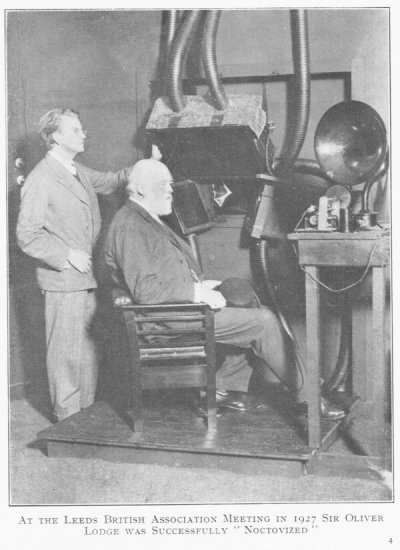
The first public indication of this "latest" development was reported in a news item on 19th February 1927, which said; 'On a suitable night we shall have an aeroplane flying overhead and pick it up on this apparatus.' The article went on to add that several governments were interested in this latest discovery, and they included Britain, America, France and Germany. Sporadic reports appeared on Baird's 'Noctovision' although they singularly failed to capture the imagination of the public. By the 1930's references to it stopped altogether.
The military aspects of 'Noctovision' were not lost on the authorities of the day, and the inventor seemed to be covering his own tracks with all the covert tactics of a well organised military operation. There is no secret in the fact that Baird was very protective of his work. Even when his inventions went on public display or were photographed for publication in the press they were altered in some respect. As McArthur and Waddell expressed in their book The Secret Life of John Logie Baird 'Pictures for public consumption rarely portrayed his equipment as used.' These were, of course, pioneering days and it is fairly certain that Baird would not want to give his competitors an edge in being the first to perfect television by revealing how he obtained his own results. However, this alone would not explain the secrecy behind Baird's work.
Dr. Peter Waddell of the University of Strathclyde, has found files of official correspondence from the 1920s and 1930s, formerly classified, describing visits of Air Ministry and Admiralty personnel to Baird's laboratories. There are suggestions that Baird was placed under a "gag order" on many aspects of his research. Although there is little information beyond the demonstration of 'Noctovision' in December 1926 it is known that Baird took out other patents during the late 1920's and early 1930's. One of these has already been described. Another called for the scanning of an object with a directional beam of ultra-short radio waves; the reflected waves of which could then be picked up by a suitable receiver and the amplified signal combined to form a picture of the object. In 1926 Baird took out a British patent for a radio spark gap transmitter for object detection. The following year he took out another British patent for a visual receiver display, which was a flat screen covered with small metal particles. By now Baird was deeply immersed in the development of detection systems and it is certain that he was fully aware of their tactical use.
With the experiments having aroused the interest of several foreign governments, the British Government were prompted to write to Baird requesting that he withhold publication of the technical details of his equipment. A letter dated 15th December 1926 and marked "SECRET" was released in the 1980's revealing the full extent of the military's interest. From the Director of Scientific Research, The Admiralty, S.W.1., it read: 'Dear Sir, with further reference to my letter of the 29th of October, I attach for your information a copy of a letter addressed to Messrs. Television Ltd. to Lieutenant Colonel Lefroy of the Royal Aircraft Establishment dated 7th of October last in which the proposal is made for a demonstration of automatic spotting by radio transmission. As it is not desired to duplicate in any way the work you have already in hand at the Admiralty Research Laboratory, I would suggest that the firm's proposal should be considered by you and a reply sent. I would add that the Air Ministry would be very willing to give any assistance to you that might lie in their power in furtherance of any work of this nature.'
It was not long before the British armed forces were researching detection systems themselves and by 1928 the British Royal Navy applied for a provisional secret GB patent for the 'Detection of Ships and Aircraft by Reflected Radio Waves.' Before that, however, Baird had applied for an American patent for the infrared version of the 'Noctovisor.' This application also contained information missing from its British counterpart, yet another example of how Baird would intentionally separate aspects of the same experiment in order to maintain secrecy. The American patent not only referred to object detection but also to signalling.
By 1930 Baird's Televisor was already being used in areas other than television. In an article for Television published in November of that year E. V. Appleton, a friend of Baird, described how he'd used it to measure the height of the ionosphere, a large, ionised gas layer at the top of the Earth's atmosphere that absorbs radiation from the sun leaving the gas molecules or atoms positively charged. These ionised layers reflect short-wavelength radio waves making long-distance radio communication possible. Appleton transmitted television images upwards from the ground to reflect the layer while the same image was also sent by land to the Televisor. The two images arrived at different times and on different positions on the Televisor appearing on the screen as 'echo blips'. By this method Appleton was able to accurately calculate the height of the layer. The test results prompted another English researcher, E. L. C. White to take things even further. He refined the technique to devise a single two-blip system with pulses coming directly from the transmitter and the reflecting object.
So, what has this got to do with Baird apart from the fact that his Televisor was used in the experiments? One could be forgiven for thinking nothing at all, until we remember the account given by Norman Loxdale of Baird's experiments in 1923. "He then moved the reflector towards the sea and he said to me: "Come along and look at this." It wasn't fluorescing. All I saw was a brownish picture, not quite a picture. Something was moving on the screen." And what of the account given by Alex Horn's widow of the objects her husband was secretly making for Baird in the 1920's. Years later, she described these components to an engineering lecturer at Melbourne University, who told her that they sounded remarkably like radar components. From what we know of Baird's history, the 1926 patents (as well as the secret patents he applied for), the fact that Baird and Appleton were friends who shared a common interest and it was later Appleton who suggested to White that he employ the two-blip radar method, builds up a strong circumstantial case to support the theory that the starting point of all modern radar experimentation can be traced back to John Logie Baird.
